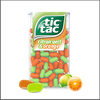E334 - L(+)-tartaric acid
Functions: Antioxidant, Sequestrant
Tartaric acid is a white, crystalline organic acid that occurs naturally in many fruits, most notably in grapes, but also in bananas, tamarinds, and citrus. Its salt, potassium bitartrate, commonly known as cream of tartar, develops naturally in the process of winemaking. It is commonly mixed with sodium bicarbonate and is sold as baking powder used as a leavening agent in food preparation. The acid itself is added to foods as an antioxidant and to impart its distinctive sour taste. Tartaric is an alpha-hydroxy-carboxylic acid, is diprotic and aldaric in acid characteristics, and is a dihydroxyl derivative of succinic acid. - Wikipedia
4,204 products
-
Sprite Goût Original - 33 cl

-
Hacendado
-
Napolitain l'original - LU - 12 x 30g

-
Pain campagnard Gerblé sans gluten - 350 g

-
Süßstoff - Lidl - 1pcs

-
chocolat brownie - Milka - 180 g (6 x 30 g)

-
Premium Ginger Beer - Fever Tree - 500ml

-
Polenta pronta - Belbake - 1 kg

-
Orange - Tic tac - 49 g

-
hummus clasico - chef select - 200 G
-
Schär - 370g

-
Glutenfrei Ciabatta - Schär - 200g

-
Takis Hot - 140 g

-
FEVER-TREE PREMIUM NATURAL MIXERS PREMIUM GINGER BEER MADE WITH NATURAL GINGERS - 200ml

-
Sablés au deux céréales Chocolat lait - Carrefour Bio - 160 g

-
Wraps, Gluten-free - Schär - 160g

-
Tic Tac orange - 18 g

-
Dusgestive chocolate con leche - Sondey - 300 g

-
Skittles Crazy Sour - 14 g.

-
Mes cookies Bio tout chocolat - Aline & Olivier - 180 g

-
Bonbons Tic Tac x110 pastilles ORANGE & CITRON VERT - 54g - Ferrero - 54 g

-
Sauce blanche - Samia - 357 g

-
Gluten Free Brown Ciabatta Rolls - Schär - 4 x 50g

-
Chewing-gum - Mentos - 100g

-
Starmix - Haribo - 175 g

-
Brossard - P'tit Savane Rigolo Chocolate, 150g (5.3oz) - 150 g

-
Pizza Margherita - Schär - 300g

-
Hummus con aceitunas de Kalamata - Chef Select - 200 g

-
TicTac citron vert et orange - TIC TAC - 49 g

-
Ginger Beer - Schweppes - 1 litre

-
Tic tac Festival - 54 g

-
Choco brownie - Milka - 150 g (6 * 25 g)

-
Artinata Artiach Original - 210 g

-
Mayonnaise Allégé à la moutarde de Dijon - Rustica - 450 g

-
Bonbons Tic Tac x100 pastilles FESTIVAL - 49g - 49 g

-
Les p'tits curieux - Bjorg - 192 g

-
Petit-beurre Chocolat Noir - Biocoop - 150 g

-
Tic Tac Citrus Mix - 49g

-
Rollmops - Carrefour - 355 g

-
Chic Kles XXL - Hacendado - 100 g
-
Arômes naturels de citron, citron vert - Sprite - 500ml

-
Marble Cake - Schär - 250g

-
Bonbons Tic Tac x110 pastilles DUO DE FRAISES - 54g - 54 g

-
Bonbons Tic Tac x100 pastilles Acidulé goût cerise - 49g - Ferrero - 49 g

-
Sprite sans sucres - 330 ml

-
Tic tac framboise myrtille - 54 g

-
Sweet Potato Wraps 6 x (252g) - BFree - 6 x 42 g

-
Monster Energy Punch baller's blend - 0,5 litre

-
Chocup - Excelo - 30 g

-
Gluten Free Pizza Base 2 x (300g) - Schär

-
Top cookies - Excelo - 32 g

-
Heisse Tasse - Tomaten-Creme - Erasco - 150 ml

-
Choco Brownie - Milka - 150 g

-
Ketchup picant - Regal - 450g

-
Stone baked pitta bread - Bfree - 220 g

-
Salad Cream - Tesco - 450 ml

-
Pain de mie extra moelleux - Chabrior - 55 g
-
Sablé - Carrefour Bio - 130 g

-
Tic tac goût agrumes - Tic Tac Ferrero - 54 g

-
Savane P’tit moelleux - Brossard

-
gum mentos - mentos Goût Fraise 🍓 - 100g, 50 dragées

-
Biscuit petit beurre tab choco lait - Biocoop - 150 g

-
Sal de frutas sabor limón - Hacendado - 250g

-
Barre muesli abricot & yaourt - Hacendado - 150 g e (6 * 25 g)

-
Tomato al Gusto - Kräuter - Knorr - 370g

-
Hummus con tomate y albahaca - chef select - 200 g

-
Digestive chocolate negro - Sondey - 300 g

-
Malabar - 214 g

-
Rollmops au vinaigre - Pêche Océan - 400 g

-
top cookies original - Excelo - 32 g

-
Choco Brownie - Milka - 2 x 25g

-
Bollycao Cacao - Bimbo - 180 g (4 x 45 g)

-
Super Sandwich - SCHÄR - 280 g

-
4 Toasting Muffins - Warburtons - 256g (4)

-
Mes cookies bio noisettes - Aline & Olivier - 180 g

-
Navette de Provence - castellane - 300 g

-
Maiomix - Regal

-
Grainy - Be - 4 biscuits 50grammes

-
Martini sans alcool - Floreale - 750mL

-
2 Rouleaux de printemps crevettes - Agis - 200 g

-
Alcohol free 0.0% - Tanqueray - 700ml

-
Chewing-gum Hollywood Strawberry - Strawberry parfum fraise - 14g

-
Chewing gum mentos pure fresh sans sucre goût tropical - 100 g

-
اخضر Crazy sours - Skittles - 174 g

-
Napolitanas de Cacao - 370 g

-
O'cake Original sa belgijskom čokoladom - 115 g

-
British sparkling spring water infused with wonky blackcurrants - Dash water - 330 ml

-
Premium ginger beer - FEVER TREE

-
Fentimans Rose Lemonade

-
Croquants - Reflets de France - 400 g

-
Galleta choco digestive - Carrefour - 300 g

-
Choco Brownie - Milka - 220 g

-
Galletas chocolate con leche - Consum - 300 g

-
Tic Tac strawberry mix - 18g

-
Riegel mit Cookies & cream-geschmack - dm - 45g

-
Édulcorant de table - Boni - 72 g

-
Hummus chili - chef select - 200 g

-
Sauce piment sriracha - Ayam - 285 g

-
Tictac - Tic Tac - 49 g

-
Active Kaugummi-Box - Watermelon - Fresh & Free - 72g (2x36g)

